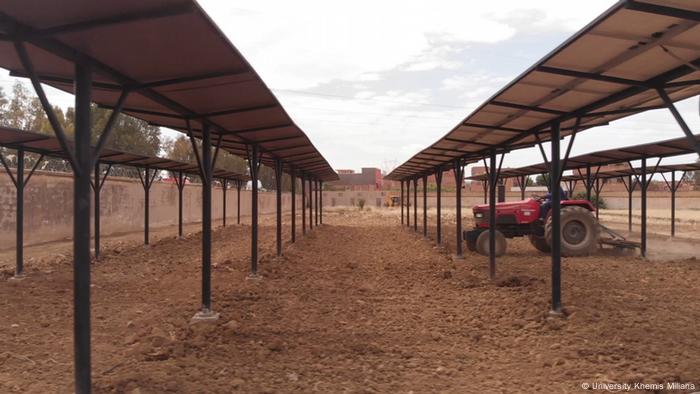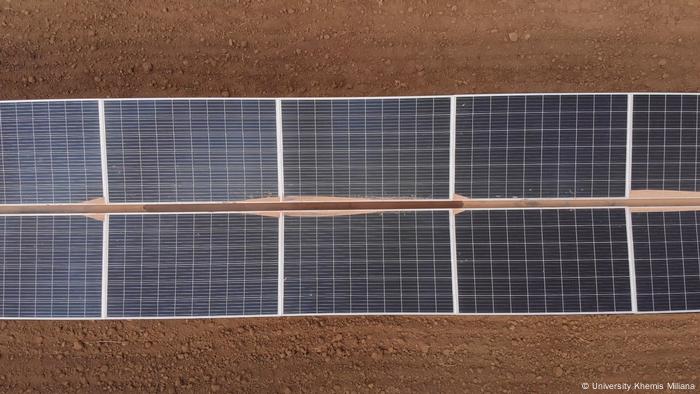Climate change puts agrivoltaic projects in Northern Africa in the spotlight
With record-high temperatures in Northern Africa and worries over food security rampant from Egypt to Morocco, agrivoltaic projects in the region are getting ever more attention.

Installing solar panels without losing agricultural areas seems like a sound idea
As food and energy security emerge as top priorities in several regions, an innovative use of existing technologies might help serve both: Agrivoltaic projects allow energy production and agricultural activity on the same land, potentially increasing farming productivity.
Several agrivoltaic pilot programs, in partnership with mainly European research centers and agencies, are underway on the African continent. Results are nearly in for the research phase of one such one project in Algeria, Watermed4.0, according to German research organization Fraunhofer ISE, one of eight institutions involved.
"We only had the first harvest of potatoes so far. Early data had some promising results: under the agrivoltaic installation there was a significantly higher yield and size of the crop compared with an uncovered reference field — about 16% more," Brendon Bingwa, project manager of Agrivoltaics Africa at Fraunhofer, told DW. Additional work will provide more data and evidence, he added.
The German Ministry for Economic Cooperation and Development (BMZ) noted that sharing experiences is essential for new processes like agrivoltaic programs. "It would be desirable if data and experiences on projects in this field were shared publicly for further assessment," a spokesperson told DW.
Helpful change in microclimate
The shading effect and ensuing improvement of the microclimate in the areas below photovoltaic modules are among the main benefits of agrivoltaic projects, which could not only increase agricultural productivity, but also allow the cultivation of new crops.
These technologies will be increasingly crucial amid climate change, said Ezio Terzini, manager of the photovoltaic and smart devices division at the NEA, Italy's public research agency. The agency has partnered in a proposed agrivoltaic project led by environmental organization Green Cross International to build a five-megawatt photovoltaic power plant in an agricultural region in Morocco.
"Many formerly fertile agricultural areas located in mild climate zones now suffer from progressive infertility due to rising temperatures or water scarcity," Terzini told DW. "Other areas are exposed to extreme weather phenomena. Agrivoltaic projects could help with both, restoring fertile conditions to areas in progressive abandonment."
Agrivoltaic projects can also produce electricity to pump and desalinate water, opening the doors to agriculture in difficult regions and desert areas.
Export potential
Terzini pointed out that the southern shores of Mediterranean countries have long boosted the spread of photovoltaic installations over large areas, exacerbating the trade-off between electricity and food production. While electricity is a medium-term necessity, food production is the short-term priority.
"The armed conflict between Russia and Ukraine is looming over a serious food crisis that will significantly affect Africa — we need to find solutions for increasing food production in this area," Terzini said.
This potential is significant. According to Fraunhofer's project manager Bingwa, the agrivoltaic projects would go beyond simply easing local food security concerns. "The project in Algeria is an example: Strawberries are the second crop. Production would satisfy local markets and allow exports, thanks to cold storage facilities, which are not part of the ongoing project, but would be an added advantage if implemented."
Future agrivoltaic projects could indeed use electricity to power cold-storage facilities to shield crops from high temperatures, prolonging the shelf life of the harvested crops.
This additional service would be controlled by data-based control systems, which are currently being tested to optimize water use.
"I hope that we will witness progress from this demonstrator phase to building them in communities in the next five years, with wider impacts on the region," Bingwa said.
A stronger local economy would also positively impact job markets, eventually decreasing the probability of migration flows.

It may be a small project, but the Algeria agrovoltaic installation shows that the underlying concept has many benefits
Though a small project, the Algerian agrovoltaic installation shows that the concept has many benefits.
Business models
The Algerian project shows how institutions from different countries — including Algeria, Germany, Spain and Turkey — can successfully combine their technological know-how. Spain's University of Murcia, for example, brought its expertise in digitalization to Watermed4.0.
The next step is to find a suitable business model to make these experimental systems pay off. According to Bingwa, public funding is critical to the research, but private investors and local players are also needed to make these projects viable and replicable.
Solar-powered irrigation systems
The research-phase agrivoltaic projects combine several technologies, including solar-powered irrigation systems. The German development agency GIZ and the Food and Agriculture Organisation of the United Nations have already worked on these systems.
The UN said that these systems require reinforcing the technical capacities of local staff and farmers. They were designed to "enable advisers and service providers to provide broad hands-on guidance to end-users, policymakers, and financiers. Thus, risks related to system efficiency, financial viability and the unsustainable use of water resources can be minimized," a FAO spokesperson told DW.
FAO is currently working on three projects in Egypt, Tunisia, and Libya. The Rome-based organization said that projects in strategic regions could provide good practice examples, allowing operations to be scaled up. That will also require the collaboration of local policymakers, which will need to create the framework for investments.
"Strong institutions and clear policy vision help advance the adoption of such technologies," the spokesperson concluded.
No comments:
Post a Comment